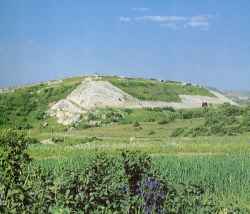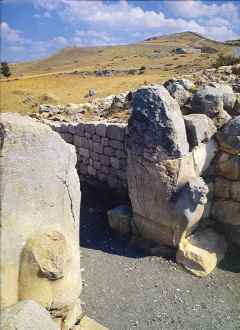General Information
BOĞAZKÖY (HATTUSA)
 The
ruins of Hattusa, the capital of the Hittite state, are situated overlying a terrace and a
huge crag rising above the present-day village known either as Boğazköy or Boğazkale. Hattusa is derived from
Hattus, the original name given to it by the Hattic people. On capturing the city, the
Hittites (P. 7 ff.) continued to use the name, except that by adding the suffix
"a" or sometimes "as", they turned it into the Hittite adaptation
"Hattusa" or "Hattusas". The oldest Hittite document discovered at
Boğazköy reveals that Hattusa was devastated at the beginning of the 18th century B. C.
by Anitta of Kussara (P. 7), who is understood to have been the greatest Hittite king
during the time of the city states. The document also states that he put a curse on the
city in the following words : "Whoever shall be king after me, if he re-settles
Hattusa, he shall be struck by the Storm God". However, the fact remains that the
Hittites re-inhabited Hattus shortly after Anitta's death, as is proved by a letter of the
Hammurabi period, discovered at Mari, in Syria, during the excavations of the French
archaeologist, André Parrot, in which Hattus is referred to by its Hittite name,
"Hattusa". This evidence reveals that the city had become Hittite by 1700 B. C.
at the latest. The
ruins of Hattusa, the capital of the Hittite state, are situated overlying a terrace and a
huge crag rising above the present-day village known either as Boğazköy or Boğazkale. Hattusa is derived from
Hattus, the original name given to it by the Hattic people. On capturing the city, the
Hittites (P. 7 ff.) continued to use the name, except that by adding the suffix
"a" or sometimes "as", they turned it into the Hittite adaptation
"Hattusa" or "Hattusas". The oldest Hittite document discovered at
Boğazköy reveals that Hattusa was devastated at the beginning of the 18th century B. C.
by Anitta of Kussara (P. 7), who is understood to have been the greatest Hittite king
during the time of the city states. The document also states that he put a curse on the
city in the following words : "Whoever shall be king after me, if he re-settles
Hattusa, he shall be struck by the Storm God". However, the fact remains that the
Hittites re-inhabited Hattus shortly after Anitta's death, as is proved by a letter of the
Hammurabi period, discovered at Mari, in Syria, during the excavations of the French
archaeologist, André Parrot, in which Hattus is referred to by its Hittite name,
"Hattusa". This evidence reveals that the city had become Hittite by 1700 B. C.
at the latest.
North of the Great Temple (plan of Boğazköy,
No. 1), the German expedition, now carrying out excavations at Hattusa, recently unearthed
the remains of buildings and small works of art belonging to the Karum Hattus settlement,
which occurred in the final phase of the Hattic era of the city, One of the Assyrian
colonies called "Karum" in ancient written sources existed at Hattusa in this
phase covering the 19th and 18th centuries B. C. (see p. 7).
 Throughout Hittite
history, both during the Old Kingdom period (1750-1450) and that of the Empire
(1450-1180), Hattusa was the capital city. The first city wall around Hattusa is thought
to have been built by King Hantili I about the beginning of the 16th century, In spite of
this fortification, the Kaska people destroyed and sacked the city about a century later
in the reign of Tudhaliya III, Nevertheless, it is understood that, within a short time,
the city and its defenses were rebuilt. The old city occupies the area between the Great
Temple and the Great Citadel, and was the scene of settlement in the Hattic age (pp., 5,
7), the City State period (2000-1750), and the time of the Old Kingdom (1750-1450). On the
other hand, the upper city, rising up south of the sally ports (see Plan of Boğazköy),
came into being in the Empire Period ( 1450 - 1180 B. C.). The city wall, which is very
well-preserved in - some places, stretches for a total of 6 km. (see plan of Boğazköy). The Hittite state came to an end
with the devastation of Hattusa by Thracian tribes in 1180 B. C. (p- 12). Throughout Hittite
history, both during the Old Kingdom period (1750-1450) and that of the Empire
(1450-1180), Hattusa was the capital city. The first city wall around Hattusa is thought
to have been built by King Hantili I about the beginning of the 16th century, In spite of
this fortification, the Kaska people destroyed and sacked the city about a century later
in the reign of Tudhaliya III, Nevertheless, it is understood that, within a short time,
the city and its defenses were rebuilt. The old city occupies the area between the Great
Temple and the Great Citadel, and was the scene of settlement in the Hattic age (pp., 5,
7), the City State period (2000-1750), and the time of the Old Kingdom (1750-1450). On the
other hand, the upper city, rising up south of the sally ports (see Plan of Boğazköy),
came into being in the Empire Period ( 1450 - 1180 B. C.). The city wall, which is very
well-preserved in - some places, stretches for a total of 6 km. (see plan of Boğazköy). The Hittite state came to an end
with the devastation of Hattusa by Thracian tribes in 1180 B. C. (p- 12).
 The
excavation of Hattusa first began in 1906, under the direction of Hugo Winckler and
Theodor Makridi. These two archaeologists were joined in the following year by Otto
Puchstein, and their work continued until 1912. A great sensation was caused by the
discovery during these excavations of tablets bearing cuneiform writing in the Great Temple. The tablets could be read, since
cuneiform writing was already known, but the deciphering of the Hittite language took a
long time. After some unsuccessful attempts by various scholars, the riddle of the Hittite
tongue was finally solved by the Czech linguist, F. Hrozny, in 191.S. The excavations were
recommenced after the First World War in 1931 with Kurt Bittel in charge and, disregarding
the interruption caused by the Second World War, have continued successfully up to the
present day. The
excavation of Hattusa first began in 1906, under the direction of Hugo Winckler and
Theodor Makridi. These two archaeologists were joined in the following year by Otto
Puchstein, and their work continued until 1912. A great sensation was caused by the
discovery during these excavations of tablets bearing cuneiform writing in the Great Temple. The tablets could be read, since
cuneiform writing was already known, but the deciphering of the Hittite language took a
long time. After some unsuccessful attempts by various scholars, the riddle of the Hittite
tongue was finally solved by the Czech linguist, F. Hrozny, in 191.S. The excavations were
recommenced after the First World War in 1931 with Kurt Bittel in charge and, disregarding
the interruption caused by the Second World War, have continued successfully up to the
present day.
Those important places worth visiting are listed here in the order in which they should
be seen : Yazılıkaya (see plan of temple at
Yazılıkaya and following), the Great Temple (plan
of temples, temple of Hatti), the Great Citadel
(see plan of Büyükkale), the King's Gate (plan of Boğazköy, No. 6), the Sphinx Gate (plan of Boğazköy, No. 11), the Tunnel and the city
wall in the vicinity of the Sphinx Gate (see picture
of wall), temples 2-4 north of the Sphinx Gate, the Lion Gate (plan of Boğazköy, No. 12), and the local museum.
Those who intend spending just one day at Hattusa are advised to visit Yazılıkaya before
proceeding to the city, because the reliefs at Yazılıkaya only receive direct sunlight
between 11 a.m., and 1 p. m.; after this time they are not distinctly visible.
|